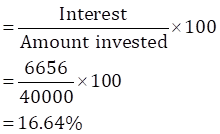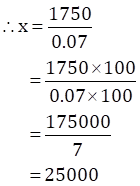Class 9 MAHARASHTRA STATE TEXTBOOK BUREAU Solutions Maths Chapter 6 - Financial Planning
Financial Planning Exercise 6.1
Solution 1
Let Alka's monthly income be Rs. x.
Since, Alka spends 90% of the money that she receives every month.
∴ Amount spent by Alka = 90% of x

Now, Savings = Income - Expenditure
∴ 120 = x - 0.9x
∴120 = 0.1 x

Thus, Alka gets Rs. 1200 monthly.
Solution 2
Original capital borrowed by Sumit = Rs. 50000
Sumit suffered a loss of 20% in his food products business in the first year.
∴ Loss suffered in the first year = 20% of 50000

Remaining capital = Original capital - loss suffered
= 50000- 10000
= Rs. 40000
Sumit invested the remaining capital i.e. Rs. 40,000 in a new sweets business and he made a profit of 5%.
∴ Profit made in sweets business = 5% of 40000

New capital with Sumit after the profit in new sweets business
= 40000 + 2000
= Rs. 42000
Since, the new capital is less than the original capital, we can conclude that Sumit suffered a loss.
Total loss on original capital = Original capital - New capital
= 50000 - 42000
= Rs. 8000
Solution 3
Let the monthly income of Nikhil be Rs x.
Since, Nikhil invested 14% in shares and deposited 3% in a bank.
∴ Total investment = (14% + 3%) of x
= 17% of x

Nikhil spent 5% on his children's education and used 40% for his daily expenses.
∴ Total expenditure = (5% + 40%) of x
= 45% of x

Amount left with Nikhil = Income - (Total investment + Total expenditure)
Since, amount left with Nikhil is 19,000
∴ 19000 = x - (0.17x + 0.45x)
∴ 19000 = x - 0.62x ,
∴ 19000 = 0.38x

∴ The monthly income of Nikhil is Rs. 50000.
Solution 4
For Mr. Sayyad:
P = Rs. 40000, R = 8%, n = 2 years
Compound interest (I) = Amount (A) - Principal (P)

∴ Mr. Sayyad's percentage of profit Interest

For Mr. Fernandes
Amount invested in mutual fund = Rs. 120000
Amount received after 2 years = Rs. 192000
∴ Profit earned by Mr. Fernandes
= Amount received - Amount invested
= 192000- 120000
= Rs. 72000
∴ Mr. Fernandes percentage of profit Profit earned

= 60%
∴ Investment of Mr. Fernandes turned out to be more profitable.
Solution 5
Let the actual income of Sameera be Rs. x.
Sameera spent 90% of her income and donated 3%.
∴ Sameera's total expenditure
= (3% + 90%) of x
= 93% of x

Now, Savings = Income - Expenditure
∴ 1750 = x - 0.93x
∴ 1750 = 0.07x

∴ The actual income of Sameera is Rs. 25000.
Financial Planning Exercise 6.2
Solution 1
(i)
Miss Nikita's age = 27 years < 60 years
Miss Nikita's income = Rs. 2,34,000
Miss Nikita's income is below the basic exemption limit of Rs. 2,50,000.
∴ Miss Nikita will not have to pay income tax.
(ii)
Mr. Kulkarni's age 36 years < 60 years
Mr. Kulkarni's income = Rs. 3,27,000
Mr. Kulkarni's income is above the basic exemption Limit of Rs.2,50,000.
∴ Mr. Kulkarni will have to pay income tax.
(iii)
Miss Mehta's age = 44 years < 60 years
Miss Mehta's income = Rs. 5,82,000
Miss Mehta's income is above the basic exemption limit of Rs.2,50,000.
∴ Miss Mehta will have to pay income tax.
(iv)
Mr. Bajaj's age = 64 years (Age 60 to 80 years)
Mr. Bajaj's income = Rs. 8,40,000
Mr. Bajaj's income is above the basic exemption Limit of Rs.3,00,000.
∴ Mr. Bajaj will have to pay income tax.
(v)
Mr. Desilva's age = 81 years > 80 years
Mr. Desilva's income = Rs. 4,50,000
Mr. Desilva's income is below the basic exemption limit of Rs. 5,00,000.
∴ Mr. Desilva will not have to pay income tax.

Solution 2
Mr. Kartarsingh's monthly income is Rs. 42,000
Mr. Kartarsingh's yearly income = 42,000 × 12 = Rs. 5,04,000
Mr. Kartarsingh's investment
= GPF + NSC
= (3000 x 12)+ 15,000
= 36,000 + 15,000
=Rs. 51,000
Donation to PM's relief fund = Rs. 12, 000
∴ Taxable income
= yearly income - (investment + donation)
= 5,04,000 - (51,000 + 12,000)
= 5,04,000 - 63,000
= Rs. 4,41,000
Mr. Kartarsingh income falls in the slab 2,50,001 to 5,00,000.
∴ Income tax = 5% of (Taxable income - 250000)
= 5% of (4,41,000 - 2,50,000)

Education cess = 2% of income tax

Secondary and Higher Education cess = 1% of income tax

Total income tax = Income tax + Education cess + Secondary and higher education cess
= 9550 + 191 + 95.50
= Rs. 9836.50
∴ Mr. Kartarsingh's income tax is Rs. 9836.50.
Financial Planning Exercise Problem set 6
Solution 1(i)
(A)
For different types of investments, the maximum permissible amount under section 80C of income tax Rs. 1,50,000.
Solution 1(ii)
(B)
A person has earned his income during the financial year 2017-18. Then his assessment year is 2018-19.
Solution 2
Let the income of Shekhar be Rs. x.
Since, Shekhar spends 60% of his income.
∴ Shekhar's expenditure = 60% of x
∴ Amount remaining with Shekhar = (100 - 60)% of x
= 40% of x

Now, he donates Rs. 300 to an orphanage from the balance left with him.
∴ Amount left with Shekhar = 0.4x - 300
Now, the amount left with him is Rs. 3200.
∴ 3200 = 0.4x - 300
∴ 0.4x = 3500
![]()
∴ The income of Mr. Shekhar is Rs. 8750.
Solution 3
For Mr. Hiralal:
Amount invested in mutual fund = Rs. 2,15,000
Amount received = Rs. 3,05,000
∴ Mr. Hiralal's profit = Amount received - Amount invested
= 305000 - 215000
= Rs. 90000
Mr. Hiralal's percentage of profit
![]()
= 41.86%
For Mr. Ramniklal:
P =Rs. 140000, R = 8%, n = 2 years
∴ Compound interest (I) = A - P

= 140000 [(1 + 0.08)2 - 1]
= 140000 [ (1.08)2 - 1]
= 140000(1.1664 - 1)
= 140000 x 0.1664
= Rs. 23296
∴ Mr. Ramniklal's percentage of profit

∴ The percentage gains of Mr. Hiralal and Mr. Ramniklal are 41.86% and 16.64% respectively, and hence, Mr. Hiralal's investment was more profitable.
Solution 4
Here, P = 24000 + 56000 = Rs. 80000, R = 7.5%, n = 3 years
Total amount after 3 years

= 80000 (1 + 0.075)3
= 80000 (1.075)3
= 80000 × 1.242297
= 99383.76
∴ The total amount after 3 years is Rs. 99383.76.
Solution 6
Let the income of Kailash be Rs. x.
Kailash spends 85% of his income.
∴ Kailash's expenditure = 85% of x

Kailash's income increased by 36%.
∴ Kailash's new income = x + 36% of x

Kailash's expenses increased by 40%.
∴ Kailash's new expenditure = 0.85x + 40% of 0.85x

∴ Kailash's new saving = Kailash's new income - Kailash's new expenditure
= 1.36x - 1.19x
= 0.17x
Percentage of Kailash's new saving
![]()
= 12.5%
∴ Kailash saves 12.5% of his new earning.
Solution 7
Let the annual income of Ramesh, Suresh and Preeti be Rs x, Rs. y and Rs. z respectively.
Since, total income of Ramesh, Suresh and Preeti = Rs. 8,07,000
∴ x + y + z = 807000 … (I)
Now, the percentages of their expenses are 75%, 80% and 90% respectively.
∴ Savings of Ramesh = (100 - 75)% of x
= 25% of x
![]()
∴ Savings of Ramesh ![]() …
(II)
…
(II)
Savings of Suresh = (100 - 80)% of x
= 20% of y
![]()
∴ Savings of Suresh ![]() …
(III)
…
(III)
Savings of Preeti = (100 - 90)% of x
= 10% of z
![]()
∴ Savings of Preeti ![]() …
(IV)
…
(IV)
Ratio of their savings = 16 : 17 : 12
Let the common multiple be k.
Savings of Ramesh = Rs. 16 k … (Given)
![]()
∴ x = 64k … (V)
Savings of Suresh = Rs. 17 k … (Given)
![]()
∴ y = 85k … (VI)
Savings of Preeti = Rs. 12 k … (Given)
![]()
∴ z = 120k … (VII)
From (I), (V), (VI) and (VII), we get
64k + 85k + 120k = 807000
∴ 269k = 807000
∴ k = 807000/269
∴ k = 3000
∴ Annual saving of Ramesh = 16k
= 16 × 3000
= Rs. 48,000
Annual saving of Suresh = 17k
= 17 × 3000
= Rs. 51,000
Annual saving of Preeti = 12k
= 12 × 3000
= Rs. 36,000
∴ The annual savings of Ramesh, Suresh and Preeti are Rs. 48,000, Rs. 51,000 and Rs. 36,000 respectively.
Solution 8
(i)
Mr. Kadam is 35 years old and his taxable income is Rs. 13,35,000.
Mr. Kadam's income is more than Rs. 10,00,000.
∴ Income tax = Rs. 1,12,500 + 30% of (taxable income - 10,00,000)
= Rs. 1,12,500 + 30% of (13,35,000 - 10,00,000)
![]()
= 112500 + 100500
= Rs. 213000
Education cess = 2% of income tax
= 2100 × 213000
= Rs. 4260
Secondary and Higher Education cess
= 1% of income tax

Total income tax
= Income tax + Education cess + Secondary and higher education cess
= 213000 + 4260 + 2130
= Rs. 2,19,390
∴ Mr. Kadam will have to pay income tax of Rs. 2,19,390.
(ii)
Mr. Khan's taxable income = Rs. 4,50,000 and his age = 65 years
So, Mr. Khan's income falls in the slab Rs. 3,00,001 to Rs. 5,00,000.
∴ Income tax
= 5% of (taxable income - 300000)
= 5% of (450000 - 300000)

Education cess = 2% of income tax

Secondary and Higher Education cess
= 1 % of income tax

Total income tax = Income tax + Education cess + Secondary and higher education cess
= 7500+ 150 + 75
= Rs. 7725
∴ Mr. Khan will have to pay income tax of Rs. 7725.
(iii)
Miss Varsha's taxable income = Rs. 2,30,000 and her age = 26 years
∴ The yearly income of Miss Varsha is less than Rs. 2,50,000.
Hence, Miss Varsha will not have to pay income tax.
Solution 5
Let the income of Mr. Manohar be Rs. x.
Amount given to elder son = 20% of x
Amount given to younger son = 30% of x
Total amount given to both sons = (20 + 30)% of x = 50% of x
Amount remaining with Mr. Manohar
= (100 - 50)% of x
= 50% of x

He gave 10% of the balance income as donation to a school.
Amount donated to school
= 10% of 0.5x

∴ Amount remaining with Mr. Manohar after donating to school
= 0.5x - 0.05x
= 0.45x
Mr. Manohar still had 1,80,000 for himself after donating to school.
∴ 180000 = 0.45x

∴ The income of Mr. Manohar is Rs. 4,00,000.

